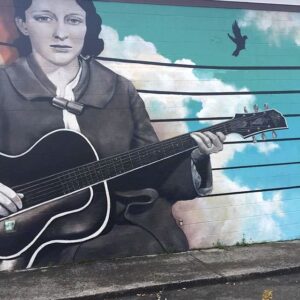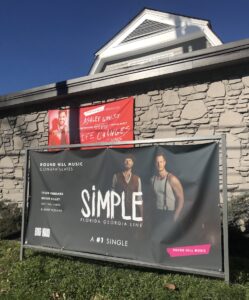By Maria Josefine Brox, Kristin Dahle and Yuk Ho Chan
What does it take to make a good country song? You imagine, maybe, the heartbroken songwriter sitting alone with her guitar on the front porch of her Mama´s house, where ‘three chords and the truth’ gives birth to another country classic for you to sing along to.
Long ago this may have been the case, but times are a-changing in an industry struggling to keep up revenues now that CD-sales are at an all time low. In order for the record-labels to keep their wallets fat, recording artists are now obligated to co-write their own songs. This puts songwriters in a position where they have to navigate the songwriting process where they wish to maintain status among peers while keeping the recording artist happy. The recording artist acts as a gatekeeper – where they are the ones deciding what goes and not. With the recording artist as the gatekeeper songwriters can not necessarily create to their heart’s content, but they have found ways to work around this.

Mural of Maybelle Carter, early country music artist and songwriter, on the side of Carter Vintage Guitars in the Gulch neighborhood of Nashville. Photo by Rachel Skaggs.
Dr. Rachel Skaggs, assistant professor of Arts Management at The Ohio State University, wishes to seek a broader understanding of the creative process, and also see how different dynamics affect collaborations on creative projects. She studied country songwriters who cowrote country songs that were commercially successful and/or critically acclaimed between the period of 2000 and 2015. Through these studies she saw the two strategies the songwriters use to navigate around: “bespoke facilitation” and “manipulation dance”. Through these strategies songwriters are able to express themselves and their creativity in a way that (hopefully) does not come across as a problem for the artists.
In her article, Skaggs define “bespoke facilitation” as a strategy where “the songwriters custom forges the song’s lyrical content, thematic elements, melodic lines, tempo, and requisite vocal range for the artist’s voice, sensibilities and personal brand” (Skaggs, p. 368). It attempts to fit the artists’ image or even their real personalities, which can help build a stronger connection between the song and the artist. With this approach the artist can build a more valid, obvious, and consistent image.
Just like “bespoke facilitation”, “manipulation dance” is another commonly used strategy in the music industry nowadays. It is defined as “a strategy meant to deceive the artist to believe that prewritten lyrical and musical content from the songwriter was in fact an in-the-moment creation of the collaboration with the recording artist” (Skaggs, p. 368). This way, songwriters are able to heavily guide the cowriting process of the song. It is not difficult to understand why it is the most commonly used strategy; imagine a superstar with a very tight schedule – and their willingness to sit down for hours to write a song. By adopting the “manipulation dance” strategy, the artists can enjoy the outcome of a song with less effort and saved time.

A banner outside Round Hill Music in Nashville’s Music Row neighborhood. Round Hill Music, like many Nashville record labels and publishing houses, usually has a banner in front of the building celebrating hit songs and records. Photo by Rachel Skaggs.
In order to facilitate a good creative mood, and maybe just as important – to make sure they are invited to later cowriting sessions, it is critical that the songwriter is not only able to come up with good songs with commercial potential but also to make for a ‘good hang’. According to Skaggs being a “good hang” is “the descriptor for songwriters who are fun and easy to be around” (Skaggs, p. 372), and it is one of the key factors when cowriters select collaborators.
Through the case of country-songwriters we can see how small-group, collaborative circles are effective at spurring innovation and creativity (Skaggs, p. 370). In the article it is stated that if you are in the room of a songwriting session, it doesn’t really matter whether or not you contribute, as you being in the room makes the session different and unique. The songwriters talk about how the final song is a collective result from the collaboration, and not something to be attributed to just one or some of the collaborators.
Meanwhile back at Mama’s, there is a sentiment among the songwriters of being in a ‘desperation mode’, that the constraints on creative freedom has brought about a more repetitive style. At this point there is little the songwriters can do about it but to try and ‘ride it out’.
This post by three students from The University of Stavanger, Norway is based on insights from the following publication: Skaggs, Rachel. 2019. “Harmonizing Small-Group Cohesion and Status in Creative Collaborations: How Songwriters Facilitate and Manipulate the Cowriting Process,” Social Psychology Quarterly, 82(4):367-385.
About the authors

Yuk Ho Chan, Kristin Dahle and Maria Josefine Brox.
Maria is a creative political science student trying to find her place in the world – one article at a time. Otherwise she is fond of travelling, knitting, going on hikes in the beautiful Norwegian nature, her cat Alfred, a good discussion, and a warm cup of tea.
Kristin’s education is in art and culture management, and teaching (arts and crafts, and English). She has worked for 18 years, mostly happily, as a bookseller/book store manager, but is now finding her way back to the arts and culture. She spends summers by the spectacular Geiranger Fjord, renting out cabins at her family’s old farm there to hikers from all corners of the world. At the moment, her favorite country song is “Crazy as a Loon.”
Yuk Ho Chan is a fourth-year Human Resource Management student at Lingnan University in Hong Kong. In 2017-2018 he was the internal vice-president of the Student Hostel Association of the Jockey Club New Hall (G) at Lingnan University. He is keen on exploring how creativity can impact personal relationships and also how it can be used in the workplace.
In Spring 2021 Maria, Kristin and Yuk are students on Ugo Corte’s course The Sociology of Creativity at the University of Stavanger, Norway.
